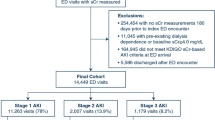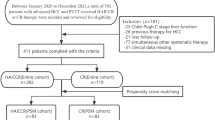Abstract
Objectives
To assess the association between low hemoglobin (Hb) level and development of contrast-induced nephropathy (CIN) for hepatocellular carcinoma (HCC) patients after transarterial chemoembolization (TACE).
Methods
A retrospective analysis was performed on 284 patients undergoing 503 consecutive sessions of TACE. Propensity score matching (PSM) analysis was used to reduce the influence of the difference in variables in normal and low hemoglobin groups. Risk factors of CIN were assessed by univariate and multivariate logistic regression analysis. The relation between Hb level and CIN development was analyzed by receiver operating characteristic (ROC) curve.
Results
CIN developed in 5.6% patients after TACE. Multivariate logistic regression analysis showed that hypertension, Hb and serum creatinine (Scr) were independent risk factors for the development of post-TACE CIN. Grouped by normal or low Hb, the incidence of CIN was 14.6% (16/110) in the low Hb group and 3.4% (4/116) in the normal Hb group after PSM. Multivariate logistic regression analysis revealed that Hb, lymphocyte count, and neutrophil to lymphocyte ratio (NLR) were independent risk factors for the development of post-TACE CIN. The optimal cut-off point at which the Hb concentration resulted in a high probability of developing CIN was 105.5 g/L in males.
Conclusions
Low Hb is an independent risk factor for post-TACE CIN. Therefore, HCC patients with low Hb levels should be closely monitored before and during TACE.

Similar content being viewed by others
Data availability
The datasets generated and/or analyzed during the current study are available from the corresponding author on reasonable request.
Abbreviations
- CIN:
-
Contrast-induced nephropathy
- HCC:
-
Hepatocellular carcinoma
- TACE:
-
Transarterial chemoembolization
- PCI:
-
Percutaneous coronary interventions
- ROC:
-
Receiver operating characteristic
- PSM:
-
Propensity score matching
- WBC:
-
White blood cell
- Hb:
-
Hemoglobin
- PLT:
-
Platelet
- ALT:
-
Alanine transaminase
- AST:
-
Aspartate transaminase
- GGT:
-
γ-Glutamyl transpeptadase
- BUN:
-
Blood urea nitrogen
- Scr:
-
Serum creatinine
- NLR:
-
Neutrophil to lymphocyte ratio
- Hb-N:
-
Normal hemoglobin
- Hb-L:
-
Low hemoglobin
References
Lufft V, Hoogestraat-Lufft L, Fels LM et al (2002) Contrast media nephropathy: intravenous CT angiography versus intraarterial digital subtraction angiography in renal artery stenosis: a prospective randomized trial. Am J Kidney Dis 40:236–242
Chou SH, Wang ZJ, Kuo J et al (2011) Persistent renal enhancement after intra-arterial versus intravenous iodixanol administration. Eur J Radiol 80:378–386
Huo TI, Wu JC, Huang YH et al (2004) Acute renal failure after transarterial chemoembolization for hepatocellular carcinoma: a retrospective study of the incidence, risk factors, clinical course and long-term outcome. Aliment Pharmacol Ther 19:999–1007
Park J, Chung HC, Lee JS et al (2008) Acute kidney injury after transarterial chemoembolization for hepatocellular carcinoma: a retrospective analysis. Blood Purif 26:454–459
Cho HS, Seo JW, Kang Y et al (2011) Incidence and risk factors for radiocontrast-induced nephropathy in patients with hepatocellular carcinoma undergoing transcatheter arterial chemoembolization. Clin Exp Nephrol 15:714–719
Hayakawa K, Tanikake M, Kirishima T et al (2014) The incidence of contrast-induced nephropathy (CIN) following transarterial chemoembolisation (TACE) in patients with hepatocellular carcinoma (HCC). Eur Radiol 24:1105–1111
Zhou C, Wang R, Ding Y et al (2014) Prognostic factors for acute kidney injury following transarterial chemoembolization in patients with hepatocellular carcinoma. Int J Clin Exp Pathol 7:2579–2586
Lee BC, Liu KL, Lin CL et al (2017) Risk of acute kidney injury after transarterial chemoembolisation in hepatocellular carcinoma patients: a nationwide population-based cohort study. Eur Radiol 27:4482–4489
Hsu CY, Huang YH, Su CW et al (2010) Renal failure in patients with hepatocellular carcinoma and ascites undergoing transarterial chemoembolization. Liver Int 30:77–84
Chong E, Poh KK, Liang S et al (2010) Risk factors and clinical outcomes for contrast-induced nephropathy after percutaneous coronary intervention in patients with normal serum creatinine. Ann Acad Med Singap 39:374–380
Murakami R, Kumita S, Hayashi H et al (2013) Anemia and the risk of contrast-induced nephropathy in patients with renal insufficiency undergoing contrast-enhanced MDCT. Eur J Radiol 82:e521-524
Guo J, Zheng C, Xiao Q et al (2015) Impact of anaemia on lung function and exercise capacity in patients with stable severe chronic obstructive pulmonary disease. BMJ Open 5:e008295
Xu J, Zhang M, Ni Y et al (2016) Impact of low hemoglobin on the development of contrast-induced nephropathy: a retrospective cohort study. Exp Ther Med 12:603–610
van der Molen AJ, Reimer P, Dekkers IA et al (2018a) Post-contrast acute kidney injury—Part 1: definition, clinical features, incidence, role of contrast medium and risk factors: recommendations for updated ESUR Contrast Medium Safety Committee guidelines. Eur Radiol 28:2845–2855
Ruilope LM, Salvetti A, Jamerson K et al (2001) Renal function and intensive lowering of blood pressure in hypertensive participants of the hypertension optimal treatment (HOT) study. J Am Soc Nephrol 12:218–225
Sahin DY, Elbasan Z, Gur M et al (2013) Neutrophil to lymphocyte ratio is associated with the severity of coronary artery disease in patients with ST-segment elevation myocardial infarction. Angiology 64:423–429
Lim C, Audureau E, Salloum C et al (2016) Acute kidney injury following hepatectomy for hepatocellular carcinoma: incidence, risk factors and prognostic value. HPB (Oxford) 18:540–548
Wu G, Zhang DY, Duan YH et al (2017) Correlations of hemoglobin level and perioperative blood transfusion with the prognosis of gastric cancer: a retrospective study. Med Sci Monit 23:2470–2478
Huang XZ, Yang YC, Chen Y et al (2019) Preoperative anemia or low hemoglobin predicts poor prognosis in gastric cancer patients: a meta-analysis. Dis Markers 2019:7606128
Kaya A, Kurt M, Tanboga IH (2014) Neutrophil-to-lymphocyte ratio predicts contrast-induced nephropathy in patients undergoing primary percutaneous coronary intervention. Angiology 65:59
Kocas C, Yildiz A, Abaci O et al (2015) Platelet-to-lymphocyte ratio predicts contrast-induced nephropathy in patients with non-ST-segment elevation acute coronary syndrome. Angiology 66:964–968
Yuan Y, Qiu H, Hu X et al (2017) Predictive value of inflammatory factors on contrast-induced acute kidney injury in patients who underwent an emergency percutaneous coronary intervention. Clin Cardiol 40:719–725
Kong T, Park YS, Lee HS et al (2018) A delta neutrophil index for the prediction of contrast-induced nephropathy in patients with St-elevation myocardial infarction followed by percutaneous coronary intervention. Shock 49:317–325
Sun XP, Li J, Zhu WW et al (2018) Platelet to lymphocyte ratio predicts contrast-induced nephropathy in patients with ST-segment elevation myocardial infarction undergoing primary percutaneous coronary intervention. Angiology 69:71–78
Jiang J, Ji HY, Xie WM et al (2019) Could platelet-to-lymphocyte ratio be a predictor for contrast-induced nephropathy in patients with acute coronary syndrome?: A systematic review and meta-analysis. Medicine (Baltimore) 98:e16801
Satilmis S, Karabulut A (2020) Value of C-reactive protein/albumin ratio in predicting the development of contrast-induced nephropathy in patients with non-ST elevation myocardial infarction. Angiology 71(4):366–371
Zorlu C, Koseoglu C (2020) Comparison of the relationship between inflammatory markers and contrast-induced nephropathy in patients with acute coronary syndrome after coronary angiography. Angiology 71:249–255
Hossain MA, Costanzo E, Cosentino J et al (2018) Contrast-induced nephropathy: pathophysiology, risk factors, and prevention. Saudi J Kidney Dis Transpl 29:1–9
van der Molen AJ, Reimer P, Dekkers IA et al (2018b) Post-contrast acute kidney injury. Part 2: risk stratification, role of hydration and other prophylactic measures, patients taking metformin and chronic dialysis patients: Recommendations for updated ESUR Contrast Medium Safety Committee guidelines. Eur Radiol 28:2856–2869
Zhang J, Guo Y, Jin Q et al (2018) Meta-analysis of rosuvastatin efficacy in prevention of contrast-induced acute kidney injury. Drug Des Devel Ther 12:3685–3690
Klause N, Arendt T, Lins M et al (1998) Hypoxic renal tissue damage by endothelin-mediated arterial vasoconstriction during radioangiography in man. Adv Exp Med Biol 454:225–234
Abu Jawdeh BG, Leonard AC, Sharma Y et al (2017) Contrast-induced nephropathy in renal transplant recipients: a single center experience. Front Med (Lausanne) 4:64
Kim SJ, Salem MR, Joseph NJ et al (1990) Contrast media adversely affect oxyhemoglobin dissociation. Anesth Analg 71:73–76
Nurko S (2006) Anemia in chronic kidney disease: causes, diagnosis, treatment. Cleve Clin J Med 73:289–297
Weiss G, Ganz T, Goodnough LT (2019) Anemia of inflammation. Blood 133:40–50
Sreenivasan J, Zhuo M, Khan MS et al (2018) Anemia (Hemoglobin </= 13 g/dL) as a risk factor for contrast-induced acute kidney injury following coronary angiography. Am J Cardiol 122:961–965
Acknowledgements
The authors gratefully appreciate the assistance of Fanyong Qu, Jiuning Huang and Shuping Zhang (Department of Radiation Oncology, Yantai Affiliated Hospital of Binzhou Medical University, Yantai, 264100, Shandong, China).
Funding
This study was supported by National Key R&D Development of China Project (Grant number: 2017YFC0113403), National Natural Science Foundation of China (Grant number: 81571635) and Binzhou Medical University Research Program and Research Foundation Project (Grant number: BY2018KJ30).
Author information
Authors and Affiliations
Contributions
YS: data collection, statistics, original draft. WS, KZ and XL: data collection. KR: monitor the clinical trial.
Corresponding author
Ethics declarations
Conflict of interest
No conflicts of interests to disclose.
Additional information
Publisher's Note
Springer Nature remains neutral with regard to jurisdictional claims in published maps and institutional affiliations.
Rights and permissions
About this article
Cite this article
Si, Y., Sun, W., Zhao, K. et al. Impact of low serum hemoglobin on development of contrast-induced nephropathy (CIN) in patients with hepatocellular carcinoma (HCC) following transarterial chemoembolisation (TACE). Int Urol Nephrol 53, 1189–1195 (2021). https://doi.org/10.1007/s11255-020-02712-7
Received:
Accepted:
Published:
Issue Date:
DOI: https://doi.org/10.1007/s11255-020-02712-7




